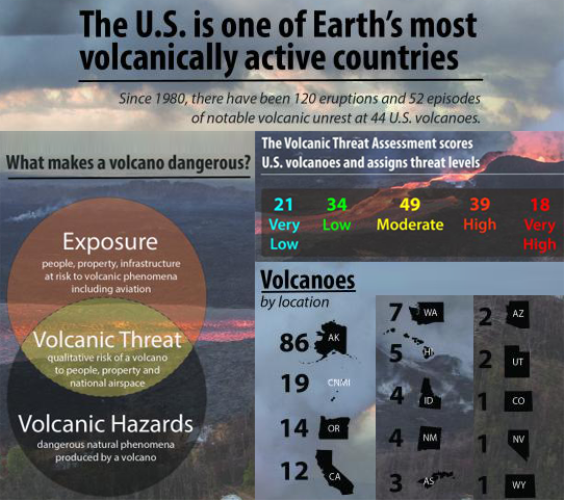National Volcano Early Warning and Monitoring System Enacted in the 116th Congress
Priority Volcanoes in the United States
In 2018, the U.S. Geological Survey (USGS, a bureau within the Department of the Interior) published a volcanic threat assessment that assigned five threat levels (very high, high, moderate, low, and very low) to 161 volcanoes in 14 states and U.S. territories (Figure 1). The assessment ranked 18 volcanoes as very high and 39 as high. Eleven of the 18 very-high-threat volcanoes are in Washington, Oregon, or California; five are in Alaska; and two are in Hawaii. The study notes that the high- and moderate-threat volcanoes are mostly in Alaska and that the more explosive Alaskan volcanoes can affect national and international aviation. The volcano ranked as the highest threat is Kilauea, the Hawaiian volcano whose 2018 eruptions were accompanied by destructive lava flows and frequent earthquakes, including one of magnitude 6.9. Kilauea is the youngest and southeastern-most volcano on the island of Hawaii.
 |
|
Source: USGS, modified by CRS. Note: CNMI (19 volcanoes) is Commonwealth of the Northern Mariana Islands; AS (three volcanoes) is American Samoa. |
National Volcano Early Warning and Monitoring System
Section 5001 of Title V of P.L. 116-9 authorizes a National Volcano Early Warning and Monitoring System within the USGS. The law directs the Secretary of the Interior to establish this system to monitor volcanoes, warn U.S. citizens of volcanic activity, and protect citizens from "undue and avoidable harm" resulting from volcanic activity. Legislation authorizing the system was introduced as Section 5001 of S. 47, the Natural Resources Management Act, on January 8, 2019, by Senators Murkowski and Cantwell. The Senate passed the bill on February 12, the House passed the bill on February 26, and the President signed it into law on March 12 as part of the John D. Dingell, Jr. Conservation, Management, and Recreation Act.
Objective and Purposes
USGS has indicated that progressively implementing an early warning and monitoring system to address a monitoring gap within its Volcano Hazards Program has been a priority since 2005. USGS asserts that a gap exists between the threat posed by a dangerous volcano and a level of monitoring commensurate with the threats they pose. Enhanced monitoring may also improve the ability to provide adequate notification and warnings in the event of dangerous volcanic activity.
Prior to enactment of Section 5001, Congress had been appropriating funds for the USGS Volcano Hazards Program, and within that program the USGS had been conducting some of the activities (e.g., monitoring, warnings, and notifications) that are newly authorized in P.L. 116-9. The new law provides an explicit authorization for an early warning and monitoring system and specifies that the system's objective is to monitor U.S. volcanoes at a level commensurate with the volcanic threat. Assessing the volcanic threat involves combining the volcano hazards—the destructive phenomena produced by a volcano, such as lava flows, ash clouds, and volcanic landslides—and the exposure to the hazard, such as the people and property at risk from a volcanic eruption (see left side of Figure 1). In the USGS 2018 volcanic threat assessment, each volcano is scored by a combination of 15 hazards factors and nine exposure factors, each summed independently, and the product of the sums is the overall threat score.
The new law states that the system shall have two purposes: (1) to organize, modernize, standardize, and stabilize the monitoring systems of the five U.S. volcano observatories (the Alaska Volcano Observatory, California Volcano Observatory, Cascades Volcano Observatory, Hawaiian Volcano Observatory, and Yellowstone Volcano Observatory) and (2) to unify the monitoring systems of these observatories into a single interoperative system.
System Components, Modernization, and Management
The new law authorizes three system components in the program: (1) a 24-hour, seven-day-a-week operational national volcano watch office; (2) a national volcano data center; and (3) an external grants program to support volcano research. The law also establishes an advisory committee for the program composed of representatives of relevant agencies and members of the scientific community and authorizes the Secretary of the Interior to enter into cooperative agreements with academic institutions and state agencies to designate them as volcano observatory partners for the system. In addition, the law requires a five-year management plan for the system, due within 180 days of enactment (i.e., by early September 2019), and an annual report describing the activities carried out under authorities provided in the law.
Section 5001 of P.L. 116-9 authorizes USGS to modernize the monitoring systems at the volcano observatories to incorporate emerging technologies, such as digital broadband seismometers, real-time Global Positioning System receivers, satellite and airborne radar interferometry, acoustic pressure sensors, and spectrometry to measure gas emissions from volcanoes. These technologies would provide more accurate and real-time or near-real-time measurements, enabling better assessments of the timing and location of volcanic eruption threats. These improvements would likely provide more accurate forecasts of aviation hazards and allow emergency managers to improve evacuation alerts and better position resources to prepare for imminent eruptions.
Funding and Authorization of Appropriations
Section 5001 of P.L. 116-9 authorizes to be appropriated a total of $55 million for the early warning and monitoring program to cover the period FY2019-FY2023. That total would be equivalent to $11 million per year. The new law states that funds made available through its authorization would supplement, not supplant, federal funds made available for other USGS hazards activities and programs. In FY2019, the USGS budget for its overall volcano hazards program was $42.6 million.